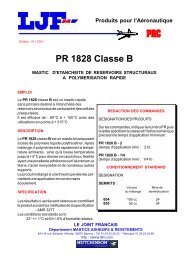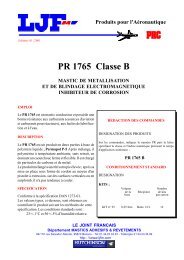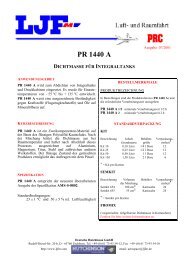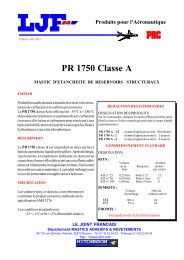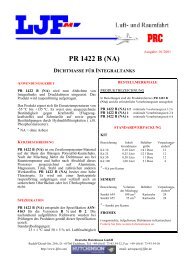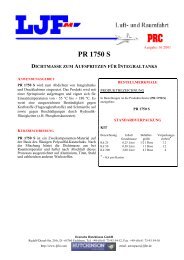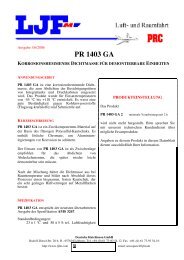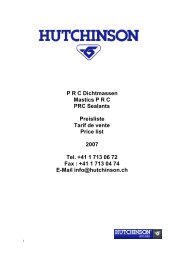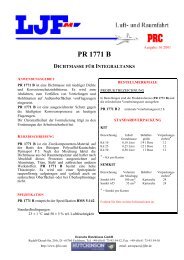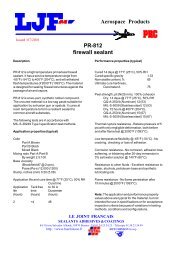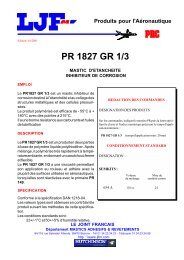PR 1440 Class B
PR 1440 Class B
PR 1440 Class B
- No tags were found...
Create successful ePaper yourself
Turn your PDF publications into a flip-book with our unique Google optimized e-Paper software.
2/4 <strong>PR</strong> <strong>1440</strong> BIssued : 04 / 2001APPLICATION <strong>PR</strong>OPERTIES (typical)- Couleur Base WhiteAccelerator Black- Mixing ratioPart A / Part B10 : 1 by weight100:8,2 (by volume)- Nonvolatile content(mixed compound) 97,5 %- Viscosity(Brookfield # 9 @ 10 rpm) 1000 Pa.s- Vertical Flow :Initial5 mm50 mn 5 mm90 mn 5 mm- Application Life and Cure TimeApplication Life Tack Free Time To 35 Shore A(hours) (hours) (hours)B 1/2 1/2 10 45B 2 2 36 72PERFORMANCE <strong>PR</strong>O<strong>PR</strong>ERTIES (typical)- Color Brown- Specific Gravity 1,55- Hardness, Shore A 56- Low temperature flexibility - 55° C-Thermal rupture resistanceRetains pressure of 70 KPa, only negligible deformationboth before and after immersion in jet reference fluid.- Adhesion - Peel strength (N/mm)JRFAlclad 2024 4 3,7Stainless steel 4,3 4,4Titanium 4 4,1Nacl/JRF100% cohesive after 70 days immersion inJRF or Nacl/JRF..- Tensile Strength and Elongation :TensileStrengthElongation(MPa) (%)- Initial 28 days 2,1 300- JRF /14 days/60°C 1,4 400- 7 days/120°C 2,8 200- JRF / 3 days/60°C+ 7 days/120°C 2,4 250- 24 hours / 120°C+ JRF 7 days/60°C 1,9 300- Fuel Résistance :-After 7 days 60°C in JRFExcellent flexibility, no visible détérioration.- Fluid change evry 24 hoursWeight lossJRF 4,5 %- Resistance to other Fluids :Excellent resistance to water, alcohols, petroleumbaseand synthetic lubrificating oils, and petroleumbasehydraulique fluids.- Réparability :Excellent to both fresh sealant and heat/fuel-abradedfillets- Fungus Resistance :Non nutrientIn harsh environment, optimum adhesion can be obtained bythe use of <strong>PR</strong> 148 AF primer.NOTE : The above application and performance propertyvalues are typical for the material, but are not intended for usein specifications or for acceptance inspection criteria becauseof variations in testing methods, conditions and configurations.SURFACE <strong>PR</strong>EPARATIONTo obtain good adhesion to metallic surface, part shall becleaned with solvents to remove dirt, grease, and processinglubricants used in manufacturing.Wash one small aera at a time, then dry with a clean clothbefore solvent evaporates to prevent redeposition of oil, waxor other surface contaminents. To maintain a clean solvantsupply, always pour the solvent on the washing cloth.



